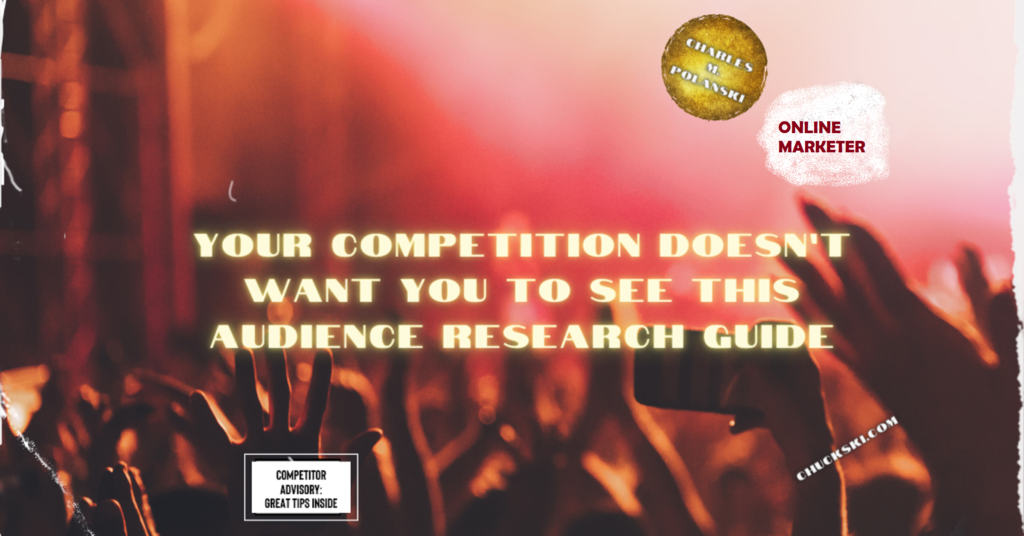
Your Competition Doesn’t Want You to See this Audience Research Guide by Charles M. Polanski, online marketer at ChuckSki.com (Image courtesy of Canva).
Knowledge is power. Knowing your audience gives you incredible power as a marketer. How do you make this happen? You must first figure out who your audience is.
As a copywriter, I have two distinct audiences. One: I have B2B: SaaS and Software companies. They hire me as a copywriter. Two: Those companies’ audiences become mine when I write for them.
Now research those target audiences intensively. Step into their shoes and their emotions.
You’ll learn the painful, hard, and complex things your audience is dealing with. Take at least one of those things. Show how your product makes it more pleasant, easy, or simple.
“The aim of marketing is to know and understand the customer so well, the product or service fits him and sells itself.” – Peter F. Drucker, author
It was a hot, humid summer’s day. But it was February. That’s because I was in Buenos Aires, Argentina. The smells of savory chimichurri and sweet dulce de leche were everywhere.
“Just be careful. Don’t root for the road team. Only cheer the home team. They’re the ones in the blue shirts with the big ‘V.’” My soccer tour guide explained.
The tour guide made sure we knew this unwritten rule of Argentine culture. In the USA, Americans can safely root for an away team.
It was 2010. The place, the western edge of Buenos Aires. I was inside Estadio José Amalfitani. “Estadio” is Spanish for stadium. It was a soccer match. The home team was Vélez Sarsfield.

View of where I sat in Estadio José Amalfitani the stadium of the Argentine soccer club Vélez Sarsfield (image courtesy of Google Maps).
My small tour group got to our seats. I noticed one fan in the front row peel off his Vélez Sarsfield jersey. I thought he wanted to cool off.
“Uh oh.” I spoke. I realized the shirt-peeling “Vélez” fan had another jersey underneath.
It was an away (aka road) team jersey.
This crazy fan started rooting hard for the road team. Insults and angry shouts came in response. Several full beers showered him.
A large mob headed down to the away fan. They weren’t stadium security. They were pissed off home fans.
They grabbed, lifted, and carried him up the stands and into the exit tunnel. The away fan thrashed about and disappeared down that dark tunnel. Who knows what happened. But I doubt it ended well.
Four years later, Argentina banned all road fans from soccer matches. Many fans have died from this violence over the years. They even killed a soccer player at one match.
The scary tale of the away fan has a lesson. This is what happens when you don’t understand your audience! That road fan should’ve known bad things happen when rooting for the wrong team at the wrong place.
I’m glad I researched soccer matches in Argentina. I knew I needed a good tour company to help me safely attend a match.
Your business won’t live too long if you don’t research your audience. Thankfully, your life is probably safe, at least!
As a copywriter, I’ve learned the importance of research. Many top copywriters preach that 80% of copywriting is research. The other 20% is writing and editing.
“The most important thing to remember is you must know your audience.” – Lewis Howes, entrepreneur
Research is central to copywriting and marketing in general. But what types of research? That is a huge topic involving many methods and subjects. I’m focusing on your audience as the subject. I’ll highlight some powerful methods for researching your audience.
First, you must identify your audience. Take a look at your customers, website visitors, email subscribers, and more. What do you know about them? Look at your competition. Identify their audiences. What can you learn about those folks?
Second, look at reviews and discussions surrounding you and your competitors. Research some of these people. What can you find from public sources like their social media? You can use people finder tools and your internal records.
Third, go directly to your audience and ask them good questions. Find out what they genuinely desire, hate, and so on. How does this align with your products and services? How can you tweak things for those prospects? Your job is to help them positively transform. How can you get them from their perceived point A to point B?
Here are 3 simple yet mighty ways to research your audience:
Action 1: Survey your existing audience. Offer them an incentive. This can be a gift card or a gift card drawing. Here are some questions to ask (but keep it survey quick and easy):
- Gender?
- Age?
- Income?
- Education?
- Profession?
- Hobbies?
- Big daily troubles, irritations, outrages, etc.?
- Biggest fears?
- Largest joys?
- They’d change what about their life?
- They’d keep what parts of their life the same?
Action 2: Ask yourself who your ideal audience is. Ask the questions from Action 1. Also ask these:
- Habits?
- Kinds of magazines read?
- Types of cars driven?
- What makes them unique?
- How do they find your brand?
- How do they interact with your brand?
- How often do they use your product? Why?
Action 3: Use a free, potent Facebook tool called “Lookalike Audiences.” Upload your email list to Facebook. They then create a lookalike audience using their massive database. They’ll find a larger crowd similar to your existing subscriber list. You can now research more people and market to them. If interested in doing this, let me know. I’ll send you the link and some tips on how to get started.
Use audience research to get clear on how to market to them. As you delve into your market, you’ll find ways to speak to and persuade them.
__________________
About Charles Polanski: I help people prosper through online marketing. Click this link to unlock a world of possibilities with online marketing.
 Your Competition Doesn’t Want You to See this Audience Research Guide by Charles M. Polanski, online marketer at ChuckSki.com (Image courtesy of Canva).
Knowledge is power. Knowing your audience gives you incredible power as a marketer. How do you make this happen? You must first figure out who your audience is.
As a copywriter, I have two distinct audiences. One: I have B2B: SaaS and Software companies. They hire me as a copywriter. Two: Those companies’ audiences become mine when I write for them.
Now research those target audiences intensively. Step into their shoes and their emotions.
You’ll learn the painful, hard, and complex things your audience is dealing with. Take at least one of those things. Show how your product makes it more pleasant, easy, or simple.
Your Competition Doesn’t Want You to See this Audience Research Guide by Charles M. Polanski, online marketer at ChuckSki.com (Image courtesy of Canva).
Knowledge is power. Knowing your audience gives you incredible power as a marketer. How do you make this happen? You must first figure out who your audience is.
As a copywriter, I have two distinct audiences. One: I have B2B: SaaS and Software companies. They hire me as a copywriter. Two: Those companies’ audiences become mine when I write for them.
Now research those target audiences intensively. Step into their shoes and their emotions.
You’ll learn the painful, hard, and complex things your audience is dealing with. Take at least one of those things. Show how your product makes it more pleasant, easy, or simple.
 View of where I sat in Estadio José Amalfitani the stadium of the Argentine soccer club Vélez Sarsfield (image courtesy of Google Maps).
View of where I sat in Estadio José Amalfitani the stadium of the Argentine soccer club Vélez Sarsfield (image courtesy of Google Maps).